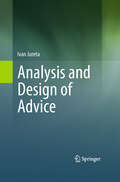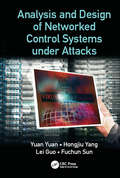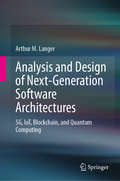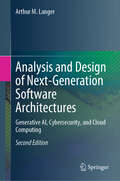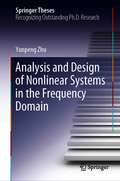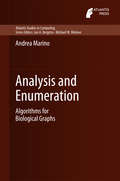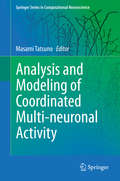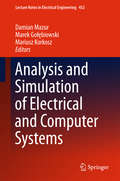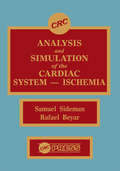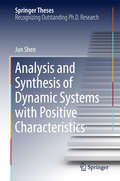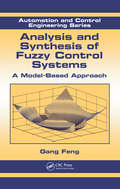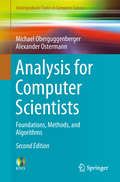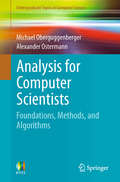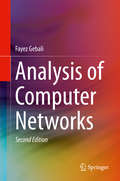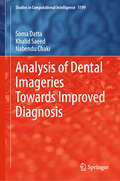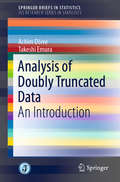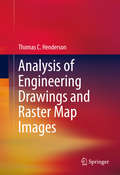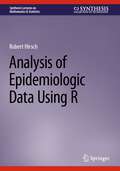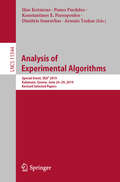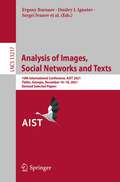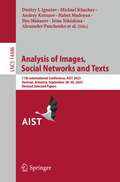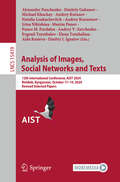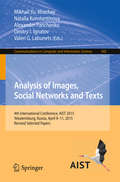- Table View
- List View
Analysis and Design of Advice
by Ivan JuretaThis innovative book offers a rigorous approach to the analysis and design of advice in real-world decision situations, in which the advisor must manage with variously imprecise, unclear, incomplete or conflicting qualitative information.
Analysis and Design of Networked Control Systems under Attacks
by Fuchun Sun Yuan Yuan Hongjiu Yang Lei GuoThis book adopts a systematic view of the control systems in cyber-physical systems including the security control of the optimal control system, security control of the non-cooperative game system, quantify the impact of the Denial-of-Service attacks on the optimal control system, and the adaptive security control of the networked control systems. Because the cyber-physical system is a hybrid system, it adopts cross layer approach to handle the security control of the CPS. It presents a number of attack models according to the attack scenario and defense facilities, and a number of cross-layer co-design methodologies to secure the control of CPS.
Analysis and Design of Next-Generation Software Architectures: 5G, IoT, Blockchain, and Quantum Computing
by Arthur M. LangerThis book provides a detailed “how-to” guide, addressing aspects ranging from analysis and design to the implementation of applications, which need to be integrated within legacy applications and databases.The analysis and design of the next generation of software architectures must address the new requirements to accommodate the Internet of things (IoT), cybersecurity, blockchain networks, cloud, and quantum computer technologies. As 5G wireless increasingly establishes itself over the next few years, moving legacy applications into these new architectures will be critical for companies to compete in a consumer-driven and social media-based economy. Few organizations, however, understand the challenges and complexities of moving from a central database legacy architecture to a ledger and networked environment.The challenge is not limited to just designing new software applications. Indeed, the next generation needs to function more independently on various devices, and on more diverse and wireless-centric networks. Furthermore, databases must be broken down into linked list-based blockchain architectures, which will involve analytic decisions regarding which portions of data and metadata will be processed within the chain, and which ones will be dependent on cloud systems. Finally, the collection of all data throughout these vast networks will need to be aggregated and used for predictive analysis across a variety of competitive business applications in a secured environment. Certainly not an easy task for any analyst/designer!Many organizations will continue to use packaged products and open-source applications. These third-party products will need to be integrated into the new architecture paradigms and have seamless data aggregation capabilities, while maintaining the necessary cyber compliances. The book also clearly defines the roles and responsibilities of the stakeholders involved, including the IT departments, users, executive sponsors, and third-party vendors. The book’s structure also provides a step-by-step method to help ensure a higher rate of success in the context of re-engineering existing applications and databases, as well as selecting third-party products, conversion methods and cybercontrols. It was written for use by a broad audience, including IT developers, software engineers, application vendors, business line managers, and executives.
Analysis and Design of Next-Generation Software Architectures: Generative AI, Cybersecurity, and Cloud Computing
by Arthur M. LangerThe 2nd edition will add a major chapter on Generative AI in Software Architecture. This chapter will provide a comprehensive background in generative models, its impact on software design, evolution of new analysis methodologies, and the overall impact of the Systems Development Life Cycle (SDLC). The new edition will also have new sections relating to Generative AI in Cybersecurity analysis and design, including proactive threat detection, ethical issues regarding privacy, and generative AI workflows (Charlotte AI). Other updates include Legacy System interfaces with Generative AI, new impacts on project management, and Platform design architecture. The 2nd edition will have a number of editing changes and corrections, as well as about 30 pages net of some eliminations of outdated content.
Analysis and Design of Nonlinear Systems in the Frequency Domain (Springer Theses)
by Yunpeng ZhuThis book focuses on the development of three novel approaches to build up a framework for the frequency domain analysis and design of nonlinear systems. The concepts are derived from Volterra series representation of nonlinear systems which are described by nonlinear difference or differential equations. Occupying the middle ground between traditional linear approaches and more complex nonlinear system theories, the book will help readers to have a good start to analyse and exploit the nonlinearities. Analysis and Design of Nonlinear Systems in the Frequency Domain provides clear illustrations and examples at the beginning and the end of each chapter, respectively, making it of interest to both academics and practicing engineers.
Analysis and Enumeration: Algorithms for Biological Graphs (Atlantis Studies in Computing #6)
by Andrea MarinoIn this work we plan to revise the main techniques for enumeration algorithms and to show four examples of enumeration algorithms that can be applied to efficiently deal with some biological problems modelled by using biological networks: enumerating central and peripheral nodes of a network, enumerating stories, enumerating paths or cycles, and enumerating bubbles. Notice that the corresponding computational problems we define are of more general interest and our results hold in the case of arbitrary graphs. Enumerating all the most and less central vertices in a network according to their eccentricity is an example of an enumeration problem whose solutions are polynomial and can be listed in polynomial time, very often in linear or almost linear time in practice. Enumerating stories, i. e. all maximal directed acyclic subgraphs of a graph G whose sources and targets belong to a predefined subset of the vertices, is on the other hand an example of an enumeration problem with an exponential number of solutions, that can be solved by using a non trivial brute-force approach. Given a metabolic network, each individual story should explain how some interesting metabolites are derived from some others through a chain of reactions, by keeping all alternative pathways between sources and targets. Enumerating cycles or paths in an undirected graph, such as a protein-protein interaction undirected network, is an example of an enumeration problem in which all the solutions can be listed through an optimal algorithm, i. e. the time required to list all the solutions is dominated by the time to read the graph plus the time required to print all of them. By extending this result to directed graphs, it would be possible to deal more efficiently with feedback loops and signed paths analysis in signed or interaction directed graphs, such as gene regulatory networks. Finally, enumerating mouths or bubbles with a source s in a directed graph, that is enumerating all the two vertex-disjoint directed paths between the source s and all the possible targets, is an example of an enumeration problem in which all the solutions can be listed through a linear delay algorithm, meaning that the delay between any two consecutive solutions is linear, by turning the problem into a constrained cycle enumeration problem. Such patterns, in a de Bruijn graph representation of the reads obtained by sequencing, are related to polymorphisms in DNA- or RNA-seq data.
Analysis and Modeling of Coordinated Multi-neuronal Activity (Springer Series in Computational Neuroscience #12)
by Masami TatsunoSince information in the brain is processed by the exchange of spikes among neurons, a study of such group dynamics is extremely important in understanding hippocampus dependent memory. These spike patterns and local field potentials (LFPs) have been analyzed by various statistical methods. These studies have led to important findings of memory information processing. For example, memory-trace replay, a reactivation of behaviorally induced neural patterns during subsequent sleep, has been suggested to play an important role in memory consolidation. It has also been suggested that a ripple/sharp wave event (one of the characteristics of LFPs in the hippocampus) and spiking activity in the cortex have a specific relationship that may facilitate the consolidation of hippocampal dependent memory from the hippocampus to the cortex. The book will provide a state-of-the-art finding of memory information processing through the analysis of multi-neuronal data. The first half of the book is devoted to this analysis aspect. Understanding memory information representation and its consolidation, however, cannot be achieved only by analyzing the data. It is extremely important to construct a computational model to seek an underlying mathematical principle. In other words, an entire picture of hippocampus dependent memory system would be elucidated through close collaboration among experiments, data analysis, and computational modeling. Not only does computational modeling benefit the data analysis of multi-electrode recordings, but it also provides useful insight for future experiments and analyses. The second half of the book will be devoted to the computational modeling of hippocampus-dependent memory.
Analysis and PDE in Latin America: ICMAM 2022 (Trends in Mathematics #10)
by Duván Cardona Brian GrajalesThis book presents the extended abstracts of the 2022 International Conference: Multidisciplinary Aspects in Mathematics and its applications (ICMAM) Latin America conference. The book presents the current state of the art in Analysis and PDEs in Latin America. Topics include: PDE models describing epidemics, population dynamics, climatological risks, oil prospection, impedance tomography in the detection of medical diseases, and abstract theory of PDEs. The extended abstracts presented in this book includes contributions by several renowned mathematicians in analysis and PDEs.
Analysis and Simulation of Electrical and Computer Systems (Lecture Notes in Electrical Engineering #452)
by Damian Mazur Marek Gołębiowski Mariusz KorkoszThis book addresses selected topics in electrical engineering, electronics and mechatronics that have posed serious challenges for both the scientific and engineering communities in recent years. The topics covered range from mathematical models of electrical and electronic components and systems, to simulation tools implemented for their analysis and further developments; and from multidisciplinary optimization, signal processing methods and numerical results, to control and diagnostic techniques. By bridging theory and practice in the modeling, design and optimization of electrical, electromechanical and electronic systems, and by adopting a multidisciplinary perspective, the book provides researchers and practitioners with timely and extensive information on the state of the art in the field - and a source of new, exciting ideas for further developments and collaborations.
Analysis and Simulation of the Cardiac System Ischemia
by Rafael Beyar Samuel SidemanOver thiry-five experts contribute to this publication about the various interactions and interrelationships of the parameters which affect the normal and ischemic heart. Mechanical aspects related to the global and regional function of the heart are discussed. Coronary perfusion of the ischemic heart is considered, with emphasis on the effects of reperfusion. Electrical activation, formation of arrhythmias, and the effects of ischemia or ionic transport in the myocardium are presented. Metabolic aspects of the ischemic heart, including calcium transport, are also explained.
Analysis and Synthesis of Dynamic Systems with Positive Characteristics (Springer Theses)
by Jun ShenThis thesis develops several systematic and unified approaches for analyzing dynamic systems with positive characteristics or a more general cone invariance property. Based on these analysis results, it uses linear programming tools to address static output feedback synthesis problems with a focus on optimal gain performances. Owing to their low computational complexity, the established controller design algorithms are applicable for large-scale systems. The theory and control strategies developed will not only be useful in handling large-scale positive delay systems with improved solvability and at lower cost, but also further our understanding of the system characteristics in other related areas, such as distributed coordination of networked multi-agent systems, formation control of multiple robots.
Analysis and Synthesis of Fuzzy Control Systems: A Model-Based Approach (Automation and Control Engineering)
by Gang FengFuzzy logic control (FLC) has proven to be a popular control methodology for many complex systems in industry, and is often used with great success as an alternative to conventional control techniques. However, because it is fundamentally model free, conventional FLC suffers from a lack of tools for systematic stability analysis and controller design. To address this problem, many model-based fuzzy control approaches have been developed, with the fuzzy dynamic model or the Takagi and Sugeno (T–S) fuzzy model-based approaches receiving the greatest attention. Analysis and Synthesis of Fuzzy Control Systems: A Model-Based Approach offers a unique reference devoted to the systematic analysis and synthesis of model-based fuzzy control systems. After giving a brief review of the varieties of FLC, including the T–S fuzzy model-based control, it fully explains the fundamental concepts of fuzzy sets, fuzzy logic, and fuzzy systems. This enables the book to be self-contained and provides a basis for later chapters, which cover: T–S fuzzy modeling and identification via nonlinear models or data Stability analysis of T–S fuzzy systems Stabilization controller synthesis as well as robust H∞ and observer and output feedback controller synthesis Robust controller synthesis of uncertain T–S fuzzy systems Time-delay T–S fuzzy systems Fuzzy model predictive control Robust fuzzy filtering Adaptive control of T–S fuzzy systems A reference for scientists and engineers in systems and control, the book also serves the needs of graduate students exploring fuzzy logic control. It readily demonstrates that conventional control technology and fuzzy logic control can be elegantly combined and further developed so that disadvantages of conventional FLC can be avoided and the horizon of conventional control technology greatly extended. Many chapters feature application simulation examples and practical numerical examples based on MATLAB®.
Analysis for Computer Scientists: Foundations, Methods, And Algorithms (Undergraduate Topics in Computer Science)
by Michael Oberguggenberger Alexander OstermannThis easy-to-follow textbook/reference presents a concise introduction to mathematical analysis from an algorithmic point of view, with a particular focus on applications of analysis and aspects of mathematical modelling. The text describes the mathematical theory alongside the basic concepts and methods of numerical analysis, enriched by computer experiments using MATLAB, Python, Maple, and Java applets. This fully updated and expanded new edition also features an even greater number of programming exercises.Topics and features: describes the fundamental concepts in analysis, covering real and complex numbers, trigonometry, sequences and series, functions, derivatives, integrals, and curves; discusses important applications and advanced topics, such as fractals and L-systems, numerical integration, linear regression, and differential equations; presents tools from vector and matrix algebra in the appendices, together with further information on continuity; includes added material on hyperbolic functions, curves and surfaces in space, second-order differential equations, and the pendulum equation (NEW); contains experiments, exercises, definitions, and propositions throughout the text; supplies programming examples in Python, in addition to MATLAB (NEW); provides supplementary resources at an associated website, including Java applets, code source files, and links to interactive online learning material.Addressing the core needs of computer science students and researchers, this clearly written textbook is an essential resource for undergraduate-level courses on numerical analysis, and an ideal self-study tool for professionals seeking to enhance their analysis skills.
Analysis for Computer Scientists: Foundations, Methods, and Algorithms (Undergraduate Topics in Computer Science)
by Michael Oberguggenberger Alexander OstermannThis textbook presents an algorithmic approach to mathematical analysis, with a focus on modelling and on the applications of analysis. Fully integrating mathematical software into the text as an important component of analysis, the book makes thorough use of examples and explanations using MATLAB, Maple, and Java applets. Mathematical theory is described alongside the basic concepts and methods of numerical analysis, supported by computer experiments and programming exercises, and an extensive use of figure illustrations. Features: thoroughly describes the essential concepts of analysis; provides summaries and exercises in each chapter, as well as computer experiments; discusses important applications and advanced topics; presents tools from vector and matrix algebra in the appendices, together with further information on continuity; includes definitions, propositions and examples throughout the text; supplementary software can be downloaded from the book's webpage.
Analysis of Boolean Functions
by Ryan O'DonnellBoolean functions are perhaps the most basic objects of study in theoretical computer science. They also arise in other areas of mathematics, including combinatorics, statistical physics, and mathematical social choice. The field of analysis of Boolean functions seeks to understand them via their Fourier transform and other analytic methods. This text gives a thorough overview of the field, beginning with the most basic definitions and proceeding to advanced topics such as hypercontractivity and isoperimetry. Each chapter includes a "highlight application" such as Arrow's theorem from economics, the Goldreich-Levin algorithm from cryptography/learning theory, Håstad's NP-hardness of approximation results, and "sharp threshold" theorems for random graph properties. The book includes roughly 450 exercises and can be used as the basis of a one-semester graduate course. It should appeal to advanced undergraduates, graduate students, and researchers in computer science theory and related mathematical fields.
Analysis of Computer Networks
by Fayez GebaliThis textbook presents the mathematical theory and techniques necessary for analyzing and modeling high-performance global networks, such as the Internet. The three main building blocks of high-performance networks are links, switching equipment connecting the links together and software employed at the end nodes and intermediate switches. This book provides the basic techniques for modeling and analyzing these last two components. Topics covered include, but are not limited to: Markov chains and queuing analysis, traffic modeling, interconnection networks and switch architectures and buffering strategies.
Analysis of Dental Imageries Towards Improved Diagnosis (Studies in Computational Intelligence #1199)
by Khalid Saeed Nabendu Chaki Soma DattaThis book provides an insight on different types of hardware and software-based caries detection methods and their limitations from treatment perspective. The different chapters are motivated to address some of the important gaps in the prevailing approaches and suggest suitable solution to them. Overall, it helps the reader to understand the caries detection methods to identify interproximal and occlusal caries. This also assists the practitioners. The book identifies multiple research issues on dental caries detection that open the practitioners’ horizons to an array of domains from which they can conclude practical insights about their area of interest.
Analysis of Doubly Truncated Data: An Introduction (SpringerBriefs in Statistics)
by Takeshi Emura Achim DörreThis book introduces readers to statistical methodologies used to analyze doubly truncated data. The first book exclusively dedicated to the topic, it provides likelihood-based methods, Bayesian methods, non-parametric methods, and linear regression methods. These procedures can be used to effectively analyze continuous data, especially survival data arising in biostatistics and economics. Because truncation is a phenomenon that is often encountered in non-experimental studies, the methods presented here can be applied to many branches of science. The book provides R codes for most of the statistical methods, to help readers analyze their data. Given its scope, the book is ideally suited as a textbook for students of statistics, mathematics, econometrics, and other fields.
Analysis of Engineering Drawings and Raster Map Images
by Thomas HendersonThis book covers up-to-date methods and algorithms for the automated analysis of engineering drawings and digital cartographic maps. The Non-Deterministic Agent System (NDAS) offers a parallel computational approach to such image analysis. The book describes techniques suitable for persistent and explicit knowledge representation for engineering drawings and digital maps. It also highlights more specific techniques, e.g., applying robot navigation and mapping methods to this problem. Also included are more detailed accounts of the use of unsupervised segmentation algorithms to map images. Finally, all these threads are woven together in two related systems: NDAS and AMAM (Automatic Map Analysis Module).
Analysis of Epidemiologic Data Using R (Synthesis Lectures on Mathematics & Statistics)
by Robert HirschThis book addresses the description and analysis of occurrence data frequently encountered in epidemiological studies. With the occurrence of Covid-19, people have been exposed to the analysis and interpretation of epidemiological data. To be informed consumers of this information, people need to understand the nature and analysis of these data. Effort is made to emphasize concepts rather than mathematics. Subjects range from description of the frequencies of disease to the analysis of associations between the occurrence of disease and exposure. Those analyses begin with simple associations and work up to complex relationships that involve the control of extraneous characteristics. Analyses rely on the statistical software R, which is freeware in wide use by professional epidemiologists and other scientists.
Analysis of Experimental Algorithms: Special Event, SEA² 2019, Kalamata, Greece, June 24-29, 2019, Revised Selected Papers (Lecture Notes in Computer Science #11544)
by Panos Pardalos Ilias Kotsireas Konstantinos E. Parsopoulos Dimitris Souravlias Arsenis TsokasThis book constitutes the refereed post-conference proceedings of the Special Event on the Analysis of Experimental Algorithms, SEA² 2019, held in Kalamata, Greece, in June 2019.The 35 revised full papers presented were carefully reviewed and selected from 45 submissions. The papers cover a wide range of topics in both computer science and operations research/mathematical programming. They focus on the role of experimentation and engineering techniques in the design and evaluation of algorithms, data structures, and computational optimization methods.
Analysis of Images, Social Networks and Texts: 10th International Conference, AIST 2021, Tbilisi, Georgia, December 16–18, 2021, Revised Selected Papers (Lecture Notes in Computer Science #13217)
by Panos M. Pardalos Andrey V. Savchenko Dmitry I. Ignatov Olessia Koltsova Jari Saramäki Alexander Panchenko Michael Khachay Natalia Loukachevitch Sergei O. Kuznetsov Amedeo Napoli Elena Tutubalina Evgeny Burnaev Sergei Ivanov Andrei Kutuzov Evgenii TsymbalovThis book constitutes revised selected papers from the thoroughly refereed proceedings of the 10th International Conference on Analysis of Images, Social Networks and Texts, AIST 2021, held in Tbilisi, Georgia, during December 16–18, 2021. The 20 full papers and 5 short papers included in this book were carefully reviewed and selected from 118 submissions. They were organized in topical sections as follows: Invited papers; natural language processing; computer vision; data analysis and machine learning; social network analysis; and theoretical machine learning and optimization.
Analysis of Images, Social Networks and Texts: 11th International Conference, AIST 2023, Yerevan, Armenia, September 28–30, 2023, Revised Selected Papers (Lecture Notes in Computer Science #14486)
by Panos M. Pardalos Andrey V. Savchenko Dmitry I. Ignatov Alexander Panchenko Michael Khachay Andrey Kutuzov Elena Tutubalina Ilya Makarov Evgenii Tsymbalov Habet Madoyan Irina Nikishina Maxim Panov Sergey ZagoruykoThis book constitutes revised selected papers from the thoroughly refereed proceedings of the 11th International Conference on Analysis of Images, Social Networks and Texts, AIST 2023, held in Yerevan, Armenia, during September 28-30, 2023. The 24 full papers included in this book were carefully reviewed and selected from 93 submissions. They were organized in topical sections as follows: natural language processing; computer vision; data analysis and machine learning; network analysis; and theoretical machine learning and optimization. The book also contains one invited talk in full paper length.
Analysis of Images, Social Networks and Texts: 12th International Conference, AIST 2024, Bishkek, Kyrgyzstan, October 17–19, 2024, Revised Selected Papers (Lecture Notes in Computer Science #15419)
by Panos M. Pardalos Andrey V. Savchenko Dmitry I. Ignatov Alexander Panchenko Michael Khachay Natalia Loukachevitch Andrey Kutuzov Elena Tutubalina Andrey Kuznetsov Evgenii Tsymbalov Irina Nikishina Maxim Panov Dmitriy Gubanov Aida KasievaThis book constitutes the refereed proceedings of the 12th International Conference on Analysis of Images, Social Networks and Texts, AIST 2024, held in Bishkek, Kyrgyzstan, during October 17–19, 2024. The 16 full papers included in this book were carefully reviewed and selected from 70 submissions. They were organized in topical sections as follows: Natural Language Processing; Computer Vision; Data Analysis and Machine Learning; and Theoretical Machine Learning and Optimization.
Analysis of Images, Social Networks and Texts: 4th International Conference, AIST 2015, Yekaterinburg, Russia, April 9–11, 2015, Revised Selected Papers (Communications in Computer and Information Science #542)
by Dmitry I. Ignatov Natalia Konstantinova Mikhail Yu. Khachay Alexander Panchenko Valeri G. LabunetsThis book constitutes the proceedings of the Fourth International Conference on Analysis of Images, Social Networks and Texts, AIST 2015, held in Yekaterinburg, Russia, in April 2015. The 24 full and 8 short papers were carefully reviewed and selected from 140 submissions. The papers are organized in topical sections on analysis of images and videos; pattern recognition and machine learning; social network analysis; text mining and natural language processing.
